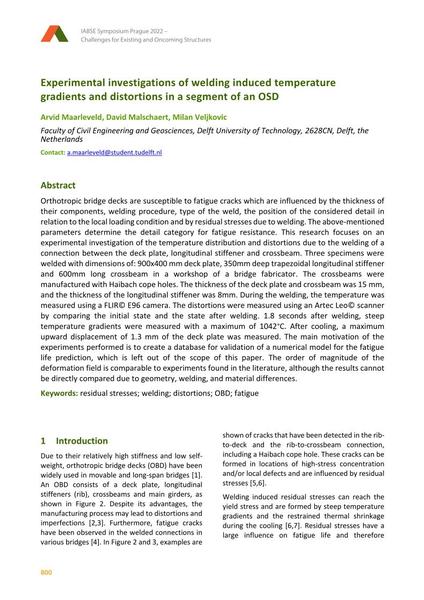Experimental investigations of welding induced temperature gradients and distortions in a segment of an OSD

|
|
|||||||||||
Détails bibliographiques
| Auteur(s): |
Arvid Maarleveld
(Faculty of Civil Engineering and Geosciences, Delft University of Technology, 2628CN, Delft, the Netherlands)
David Malschaert (Faculty of Civil Engineering and Geosciences, Delft University of Technology, 2628CN, Delft, the Netherlands) Milan Veljković (Faculty of Civil Engineering and Geosciences, Delft University of Technology, 2628CN, Delft, the Netherlands) |
||||
|---|---|---|---|---|---|
| Médium: | papier de conférence | ||||
| Langue(s): | anglais | ||||
| Conférence: | IABSE Symposium: Challenges for Existing and Oncoming Structures, Prague, Czech Republic, 25-27 May 2022 | ||||
| Publié dans: | IABSE Symposium Prague 2022 | ||||
|
|||||
| Page(s): | 800-809 | ||||
| Nombre total de pages (du PDF): | 10 | ||||
| DOI: | 10.2749/prague.2022.0800 | ||||
| Abstrait: |
Orthotropic bridge decks are susceptible to fatigue cracks which are influenced by the thickness of their components, welding procedure, type of the weld, the position of the considered detail in relation to the local loading condition and by residual stresses due to welding. The above-mentioned parameters determine the detail category for fatigue resistance. This research focuses on an experimental investigation of the temperature distribution and distortions due to the welding of a connection between the deck plate, longitudinal stiffener and crossbeam. Three specimens were welded with dimensions of: 900x400 mm deck plate, 350mm deep trapezoidal longitudinal stiffener and 600mm long crossbeam in a workshop of a bridge fabricator. The crossbeams were manufactured with Haibach cope holes. The thickness of the deck plate and crossbeam was 15 mm, and the thickness of the longitudinal stiffener was 8mm. During the welding, the temperature was measured using a FLIR© E96 camera. The distortions were measured using an Artec Leo© scanner by comparing the initial state and the state after welding. 1.8 seconds after welding, steep temperature gradients were measured with a maximum of 1042°C. After cooling, a maximum upward displacement of 1.3 mm of the deck plate was measured. The main motivation of the experiments performed is to create a database for validation of a numerical model for the fatigue life prediction, which is left out of the scope of this paper. The order of magnitude of the deformation field is comparable to experiments found in the literature, although the results cannot be directly compared due to geometry, welding, and material differences. |
||||
| Copyright: | © 2022 International Association for Bridge and Structural Engineering (IABSE) | ||||
| License: | Cette oeuvre ne peut être utilisée sans la permission de l'auteur ou détenteur des droits. |
||||
